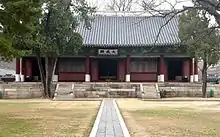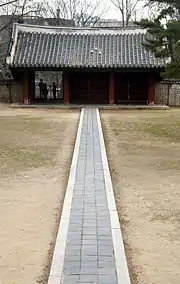| Sungkyunkwan | |
 Myeongnyundang Lecture Hall of Sungkyunkwan | |
| Korean name | |
|---|---|
| Hangul | |
| Hanja | |
| Revised Romanization | Seonggyungwan |
| McCune–Reischauer | Sŏnggyun’gwan |
Sungkyunkwan (Korean: 성균관) was the foremost educational institution in Korea during the late Goryeo and Joseon Dynasties. Today, it sits in its original location, at the south end of the Humanities and Social Sciences Campus of Sungkyunkwan University in Seoul, South Korea. Twice a year, in May and September, the ceremonial rite Seokjeon Daeje is performed in the Munmyo Shrine, to honor Confucius and the Confucian sages of China and Korea.
Etymology
- Sung (RR: Seong) (성, 成) – accomplish, achieve. To become capable, successful or to win. “To perfect or develop human nature”.
- Kyun (RR: Gyun) (균, 均) – balance, to be. Strengthen culture according to social standards or norms. “To build a good society”.
- Kwan (RR: Gwan) (관, 館) – institute, academy, university.
History


Sungkyunkwan was established in Hanyang on September 25, 1398. It was renamed, destroyed, and rebuilt several times. In 1895, it was reformed into a modern three-year university. During the colonial era (between 1910 and 1945), Sungkyunkwan was demoted to a private institution and renamed Gyeonghagwon (경학원, 經學院), while Korean education was prohibited and Japanese education was forced nationwide. After Korea gained independence in 1945, Gyeonghagwon's original name was restored and with funding from Yurim (Confucians) nationwide, Sungkyunkwan University was established.
Design features
The old campus was designed based on geomancy. Sungkyunkwan was built with the mountains behind it to the north and the front facing south towards water (the Han River and Bansu, the creek that used to run around the front of the campus). This was based on superstition as well as function. The sunlight and wind patterns were considered most ideal when the buildings were arranged this way.
Education
The primary written language of Sungkyunkwan was Hanja. Sungkyunkwan's teachings were mainly Confucian-related, and were primarily aimed at preparing students for government service. Students also studied law, medicine, interpretation, accounting, archery, mathematics, music, and etiquette. But the main goal was for the students to pass the higher national civil service examinations (gwageo). Like their Chinese counterpart, these examinations were on writing ability, knowledge of the Confucian classics, and proposals of management of the state (governance). Technical subjects were also included to appoint experts in medicine, interpretation, accounting, and law. The original set number of students was 150 when Sungkyunkwan was founded, which was raised to 200 in 1429. All of the students were male and women were forbidden from entering the campus.
Entrance examinations for Sungkyunkwan were extremely harsh and were only allowed for the sons of yangban, the Joseon era upper class or royalty. There were two ways to be accepted into Sungkyunkwan. Either the students had to pass the two admission exams, Saengwonsi (생원시) and Jinsasi (진사시), or take the other two examinations, Seungbo (승보) and Eumseo (음서). If they passed these examinations, they were given the opportunity to be accepted.
Students lived very comfortably on full scholarship and were waited on by servants.[1]
Images
 The 1000 KRW banknote shows Confucian scholar Yi Hwang and Myeongnyundang.
The 1000 KRW banknote shows Confucian scholar Yi Hwang and Myeongnyundang. This map from 1785 shows the original campus of Sungkyunkwan. Most of the buildings to the west are gone.
This map from 1785 shows the original campus of Sungkyunkwan. Most of the buildings to the west are gone. Bicheondang
Bicheondang Daeseongjeon, with the doors open.
Daeseongjeon, with the doors open. Jongyeonggak, Korea's oldest library.
Jongyeonggak, Korea's oldest library. The lecture hall of Sungkyunkwan.
The lecture hall of Sungkyunkwan. This building enshrines tablets to the great Confucian scholars.
This building enshrines tablets to the great Confucian scholars. Sinsammun opened its doors for APAIE delegates on 17 March 2014.
Sinsammun opened its doors for APAIE delegates on 17 March 2014. Tangpyeongbigak
Tangpyeongbigak Ginkgo tree natural monument 59 possibly planted 1398
Ginkgo tree natural monument 59 possibly planted 1398
Notable alumni
- Yi Gae (1417–1456)
- Hwang Hui (1363–1452)
- Jeong In-ji (1396–1478)
- Choe Hang (1409–1474)
- Munjong of Joseon (1414–1452)
- Shin Suk-ju (1417–1475)
- Sejo of Joseon (1414–1468)
- Kim Jong-jik (1431–1492)
- Jo Gwang-jo (1482–1519)
- Yi Hwang (1501–1570)
- Hyujeong (1520–1604)
- Yi I (1536–1584)
- Ryu Seong-ryong (1542–1607)
- Kim Jang-saeng (1548–1631)
- Yun Seon-do (1587–1671)
- Heo Mok (1587–1682)
- Yun Hyu (1617–1680)
- Gwon Sang-ha (1641–1721)
- Park Mun-su (1691–1756)
- Yeongjo of Joseon (1694–1776)
- Jeongjo of Joseon (1752–1800)
- Jeong Yak-yong (1762–1836)
- Park Gyu-su (1807–1877)
- Choe Ik-hyeon (1833–1906)
- Kim Ok-gyun (1851–1894)
- Park Eun-sik (1859–1925)
- Yi Dong-nyeong (1869–1940)
- Shin Chae-ho (1880–1936)
- Jo So-ang (1887–1959)
See also
References
- ↑ "Sung Kyun Kwan". Exploring Korea. 24 August 2011. Retrieved 16 April 2014.
External links
- Official website (in Korean)
- Sungkyunkwan University
- Munmyo Korean Tourism Site
